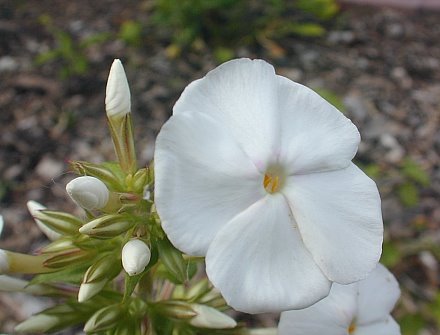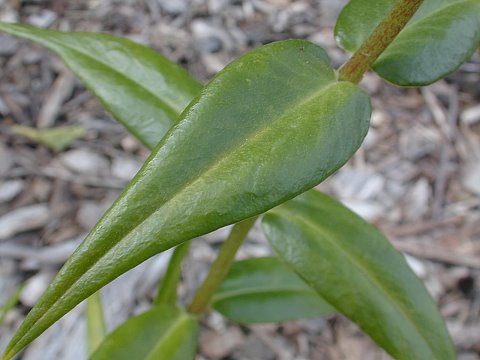Description: This perennial plant is 1-3' tall and usually unbranched. The central stem is terete, smooth, and usually glabrous; it also has numerous purple spots or streaks. The opposite leaves are medium to dark green, often with a shiny upper surface, and they are sessile against the stem or nearly so. They are about 2½-4" long and ½-¾" across. The leaves are narrowly lanceolate to lanceolate in shape and smooth along their margins; they are widest near their bases, while their tips are long and slender. Both the upper and lower surfaces of the leaves are glabrous. The central stem terminates in a panicle of flowers that is about 3-8" in length and longer than it is wide. The panicle of the typical subspecies (ssp. maculata) is cylindrical in shape (see Panicle Photo), while the panicle of spp. pyramidalis is pyramidal in shape (broader at the base than toward the apex). Individual flowers are about ¾" across, consisting of a pink, purple, or white corolla with 5 petal-like lobes, a green to purplish green calyx with 5 linear lobes (about ¼" in length), and the reproductive organs. The base of the corolla is narrowly tubular, while its petal-like lobes are obovate in shape. The calyx is shorter than the corolla and usually glabrous. The slender pedicels of the flowers are short (less than ½" in length). The blooming period occurs during the summer, lasting about 1-2 months. After the flowers wither away, they are replaced by ovoid seed capsules about 1/3" (8 mm.) in length. These capsules are 3-celled, and each cell of a capsule contains one or more seeds. The small seeds are distributed by the wind to a limited extent. The root system consists of a taproot.

Cultivation:
Preferred habitat consists of full sun to light shade, moist
conditions, and soil containing silt, loam, or sandy loam.
There
should be sufficient organic material to retain moisture. After
flowering, this plant tends to die down. If conditions are not right,
it can be short-lived.
Range & Habitat:
The native Speckled Phlox occurs in scattered counties in the northern
half of Illinois (see Distribution
Map).
It is an uncommon plant in the wild. Some populations may be plants
that have escaped cultivation, as it is a popular garden plant.
Habitats include bottomland woodlands, woodland openings, moist
meadows along rivers, banks of rivers, fens, roadsides in wooded areas,
and abandoned fields. Speckled Phlox typically occurs near
woodlands or sources of water, rather than open prairie.

Faunal Associations: The flowers are cross-pollinated by nectar-seeking butterflies, skippers, and moths. Small Syrphid flies may eat the pollen of the flowers, but they are non-pollinating. Caterpillars of the moth Heliothis turbatus (Spotted Straw) feed destructively on the flowers and buds, while caterpillars of the moth Lacinipolia olivacea (Olive Arches) feed on the foliage. Some plant bugs suck the juices of Speckled Phlox and other Phlox spp., including Lopidea davisi (Phlox Scarlet Plant Bug) and Poecilocapsus lineatus (Four-Lined Plant Bug). The larvae of a long-horned beetle, Oberea flavipes, bore through the stems. Mammalian herbivores readily consume Speckled Phlox, including rabbits, groundhogs, and deer. It can be difficult to maintain populations of this uncommon plant when these animals are abundant.

Photographic
Location:
The photographs were taken at a flower garden along a sidewalk in
Urbana, Illinois.
Comments:
This is another lovely Phlox species (Phlox sp.)
that is uncommonly encountered in the wild. Wild plants with white
flowers, in particular, are quite rare. Speckled Phlox can be
distinguished from other Phlox
spp. in Illinois by its purple-spotted stems and elongated
panicles of flowers. Unlike Speckled Phlox, other Phlox spp.
within the state have panicles of flowers that are wider than they are
tall. The photographed plant is a cultivar with white flowers, but it
has features that are typical of wild plants. Its cylindrical panicle
of flowers is a key characteristic of the typical subspecies, Phlox maculata maculata.
Other common names of this plant include Spotted Phlox, Meadow Phlox,
and Wild Sweet William.